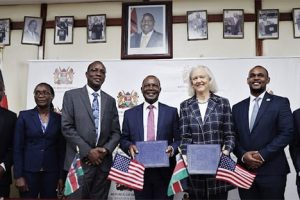
EAC’s Push for a Unified Economic Framework has the signs of a stronger Regional Economy
By Musila Muoki
A Community of Discriminatory Laws
Reportedly, East African Community member states are on the cusp of completing a review of fees, levies, and charges that are imposed by member countries on critical goods and services on cross-border transit. Spearheaded in the agriculture and transport sectors, the exercise that kicked off in 2021 seeks to harmonize or completely remove levies and charges that impact trade and costs of goods and services in the region. Often levied by individual nations in what is described as “inflated” and “discriminatory” protectionist moves, the eight-member economic bloc would benefit from move streamlined processes.
One can only hope that the move is not merely a bureaucratic exercise but rather a crucial move designed to dismantle existing trade barriers that have historically stifled trade and led to diplomatic tiffs. Despite the removal of import duty on goods under the EAC customs union protocol, Kenya for instance introduced a Kes 72 levy per tray on eggs from Uganda, a suspended levy, characterizing tariff challenges to trade. By addressing these financial impediments, the EAC is laying the groundwork for a more integrated and economically robust region.
Gearing up for a Unified Economic Framework
East African Community’s regional trade policy long term goal is to achieve sustainable and inclusive economic growth for all partner states driven by high growth rates in trade and investment activity, production, and competitive goods and services. The conduct of member states in the past has, however, sought to adopt protectionist policies, justified or otherwise, stifling trade contrary to the aspiration of the community.

Most impacted are the transport, agriculture, environment, trade, finance, energy, and tourism sectors of the region, areas that affect wealth creation and the quality of life of citizens. Tariff related tiffs between EAC nations across the sectors have done more to hamper efforts for balanced cross border trade and investment while stifling competitiveness and value addition efforts. Beginning 2021, additional levies have impacted poultry products, fish and fish products, dairy, veterinary medicine, pesticides, and human drugs across the 8 member states hindering trade. The region has also seen individual states level unharmonized charges on passenger services in air travel, landing and parking charges, navigation charges, and docking fees for cargo ships.
Supporting Regional Supply Chains
The East African Community aims to support the growth of regional value chains by building synergies between sector-based policies, trade policy reforms, and the exploitation of inclusive trade opportunities. The commitment to harmonize trade fees and levies presents a significant reduction in operational costs for traders. Specifically, this is bound to benefit small and medium-sized enterprises (SMEs) that often struggle with the high costs associated with cross-border trade. Lower financial barriers promise to create a more inclusive trading environment where SMEs can compete more effectively with better established enterprises.
“Getting ahead of the historically inflated and discriminatory charges removes major bottlenecks that cause delays, increase costs, and reduce the overall competitiveness of goods in the markets.”
The harmonization is bound to benefit supply chain systems across the region. The reduction in bureaucratic and financial obstacles will streamline logistics operations, reduce transit times, and lower transportation costs. This can enhance the overall competitiveness of businesses in the region while making it more attractive to regional and other international traders. Notably, this can also generate to better and improved infrastructure and logistical support across the region with corresponding need for better ports, roads, and warehousing emerging from growing trade volumes. This can be expected to stimulate investment in infrastructure projects, creating jobs and further boosting economic growth in the region.
Smoother and Cost-Effective Good Movement
The streamlining of trading costs in the transport and agriculture sectors marks the initial phase of a broader strategy to harmonize levies and fees across seven key sectors. Increasingly, this can be expected to further enhance cross-border trade and integration between member stages through a reduction in financial burden on traders while creating mechanism for a more smooth and cost-effective movement of goods. Getting ahead of the historically inflated and discriminatory charges removes major bottlenecks that cause delays, increase costs, and reduce the overall competitiveness of goods in the markets.
The unpredictability of terms of trade leading to the inability to estimate product operation costs due to fluctuations in levies has been a challenge for businesses in the region. With harmonization or complete removal of unwarranted fees and levies, traders can expect more predictable and fair-trading environment. This is bound to boost trade volumes following a reduction in the cost of doing business across the region. Moreover, the removal of these barriers is expected to enhance the efficiency of supply chain systems, as goods will be able to move more freely and rapidly across borders. This is a desirable addition for perishable agricultural products where timely delivery to maintain quality and market value is a key factor.
An Imperative for a single market
While the current efforts to streamline trading costs are commendable, there is more that needs to be done to fully realize the potential of the EAC as a unified economic bloc. The regional bloc needs to do more to expedite the review and harmonization process of all economic sectors to ensure a more consistent and fait trading environment across board. This notwithstanding, member states must enhance their policy coordination to avoid the reintroduction of non-tariff barriers (NTBs) that can undermine the progress made. The institution of monitoring and enforcement mechanisms to ensure compliance with the new expectations is an imperative for success.
The EAC must make progress towards the adoption of digital technologies in enhancing cross-border trade and enforcement of harmonized levies and fees. Implementing electronic single windows, digital customs clearance systems, and real-time tracking of goods can further help reduce delays and increase transparency in trade processes.



